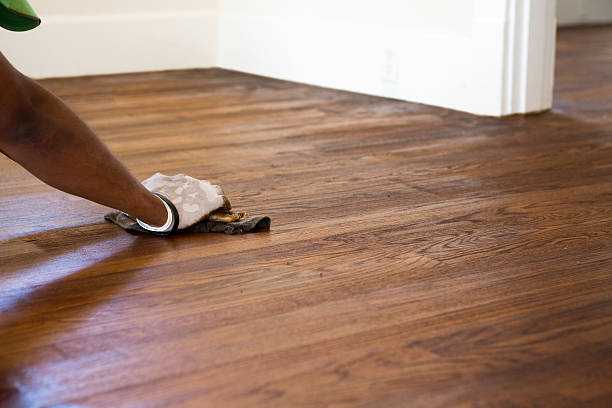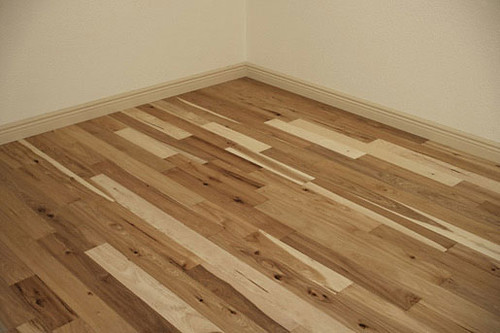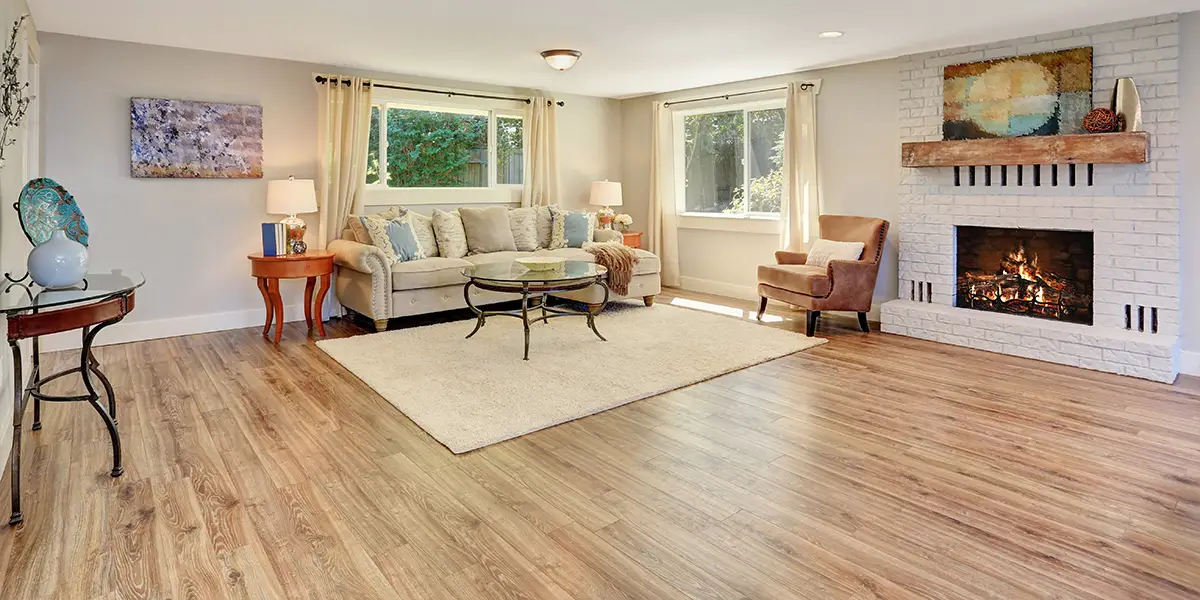Hickory flooring, famed for its exceptional durability and distinct aesthetic, has become a popular choice among homeowners and interior designers alike. However, like any flooring option, hickory offers both advantages and disadvantages that must be carefully considered before installation.
This article aims to provide a comprehensive exploration of the advantages and disadvantages of hickory flooring to help you make an informed decision.
Hickory, a type of hardwood, is renowned for its extraordinary hardness and resilience, making it a highly suitable flooring material. It is one of the toughest domestic hardwoods available on the market, thus offering remarkable resistance against dents and scratches.
Additionally, its unique grain pattern, coupled with its array of natural color variations, lends itself to a wide range of interior styles.
However, this exceptional durability comes with a higher price tag compared to other hardwood alternatives. Moreover, its intricate grain pattern, while aesthetically pleasing, can prove challenging during the installation process.
Advantages of Hickory Flooring
Durability and Hardness

Hickory flooring is arguably the epitome of resilience in the realm of hardwood floors. The Janka scale, a system that measures the hardness of various kinds of wood, ranks hickory at an impressive 1820, making it one of the hardest domestic woods available for flooring.
This extraordinary hardness translates into high durability, providing hickory floors with an uncanny ability to withstand the rigors of daily life, including high foot traffic, heavy furniture, and pets.
Furthermore, its natural resistance to dents and scratches ensures that hickory floors retain their aesthetic appeal for many years, even in the most active households.
Such enduring resilience, coupled with its distinct aesthetic, makes hickory flooring an investment that adds both beauty and value to your home for the long term.
Aesthetics: The Unique and Rustic Appeal of Hickory

The aesthetic allure of hickory flooring is as remarkable as its durability. Characterized by its diverse range of natural colors, from creamy whites to rich dark browns, and a distinct grain pattern, hickory flooring exudes a unique and rustic charm that is often irresistible.
Its dramatic contrasts in tones and intricate grain patterns confer a sense of organic beauty and timeless elegance to any space, making it a perfect choice for homeowners seeking an authentic, rustic feel or a modern, contemporary look.
Moreover, the bold, sweeping lines and knots that appear on Hickory’s surface add an extra layer of texture and depth, enhancing the overall appeal of a room.
This unique character of hickory ensures that no two planks are alike, meaning your flooring will be uniquely yours.
Whether you prefer a more traditional, polished finish or a rugged, distressed look, hickory’s versatility can cater to a broad spectrum of style preferences.
However, it’s worth noting that this dramatic variation in grain patterns may not suit everyone’s taste and maybe a bit overwhelming in smaller spaces.
Despite this, many find that this very characteristic of hickory adds personality and warmth to their interiors, imparting a sense of character that is hard to replicate with other flooring materials.
Variety: An Array of Colors and Grains
Hickory flooring offers a magnificent palette of colors and a diverse array of grain patterns, making it a unique and customizable option for your home.
The color spectrum of hickory ranges from light shades of cream and honey to deep tones of mocha and espresso, covering virtually every hue in between. These varying shades allow homeowners to choose a tone that perfectly complements their interior décor.
In terms of grain patterns, hickory showcases a unique blend of straight, wavy, and curly grains.
The straight grain gives the flooring a uniform and clean look, while the wavy and curly grains inject an element of unpredictability and character. This mix of grain patterns can create a dynamic visual effect on the floor, adding depth and dimension to any room.
Each plank of hickory flooring is like a work of art, bearing its unique grain pattern and color variation. This means that no matter how many rooms you install hickory flooring in, each will have its unique look and feel.
However, it’s important to consider that the dramatic variations in color and grain can lead to a strikingly different overall look from one plank to another.
While many appreciate this natural diversity, some might find it challenging to achieve a consistent look across a larger space. Regardless, for those who value natural beauty and wish to bring a touch of the outdoors inside, hickory flooring offers an unmatched richness and complexity of design.
Value Addition
Hickory flooring is not merely a visually appealing choice; it can also significantly enhance the value of a property.
Its natural beauty and unique characteristics make it a sought-after flooring option, potentially increasing the market value of your home.
Firstly, hickory’s resilience and longevity are major selling points. Known for its exceptional hardness and durability, hickory can withstand heavy foot traffic and resist wear and tear better than other flooring materials.
This durability can translate into long-term savings for potential homeowners, reducing the need for frequent repairs or replacements.
Secondly, hickory’s vibrant colors and diverse grain patterns can enhance the aesthetic appeal of a property. Its ability to complement a wide range of interior decor styles can attract a larger pool of potential buyers, thereby increasing the property’s marketability.
Moreover, hickory flooring is an eco-friendly choice. Using wood flooring, particularly from a sustainable source, can appeal to environmentally conscious buyers and contribute positively to a home’s green credentials.
Lastly, the unique character and inherent luxury of hickory flooring can elevate the overall perception of quality associated with a property.
For potential buyers, a well-maintained and beautifully finished hickory floor could be a determining factor in their purchase decision.
Overall, investing in hickory flooring can provide significant returns by not only enhancing the aesthetic appeal of a property but also potentially increasing its market value and desirability amongst prospective buyers.
Disadvantages of Hickory Flooring
Cost
Despite its numerous benefits, hickory flooring often comes with a higher price tag compared to other flooring options. The cost of hickory can range from $3 to $8 per square foot, not including installation fees which can add another $5 to $12 per square foot.
This high cost is primarily due to the material’s exceptional hardness and durability, as well as its aesthetic appeal.
In comparison, other popular wood flooring options such as oak, maple, or pine tend to be less expensive.
Oak flooring, for instance, usually costs between $2 to $6 per square foot, while maple and pine can range from $2 to $7 and $1 to $5 respectively. Laminate flooring, a budget-friendly alternative, can often be found for less than $1 per square foot.
It’s important to note that while the initial cost of hickory may seem steep, its longevity and minimal maintenance needs may result in longer-term savings.
Nonetheless, potential homeowners with a tight budget may find the upfront cost of hickory flooring prohibitive.
Installation

One of the common challenges encountered when installing hickory flooring stems from its exceptional hardness. Hickory ranks among the hardest of domestic wood species, with a Janka hardness rating of 1820.
This hardness can make the installation process more labor-intensive and time-consuming compared to softer woods.
Cutting and shaping hickory wood can be tough, often requiring heavy-duty tools. Additionally, hickory is more resistant to nails than softer materials, which may potentially lead to more split boards during installation.
Therefore, it’s recommended to pre-drill holes before using nails or screws, adding an extra step to the installation process.
Furthermore, hickory’s hardness can also challenge the sanding and finishing process. The dense grain may cause uneven absorption of stains and finishes, requiring careful application and potentially more coats for a consistent and appealing look.
While the installation of hickory flooring can be managed as a DIY project, its inherent hardness and precision required might make hiring a professional a more suitable option for some homeowners.
Despite the increased labor and time involved, the resulting floor’s durability, beauty, and potential longevity make hickory a worthwhile consideration.
Maintenance
Maintaining hickory flooring can present its own set of challenges due to its unique characteristics. Hickory’s dense grain which contributes to its hardness and durability can also lead to uneven wear and tear over time, especially in high-traffic areas.
This might necessitate more frequent refinishing compared to less dense hardwoods.
Cleaning hickory flooring requires special attention as well, particularly because it tends to be more prone to water damage.
Standing liquids can seep into the wood, causing stains and even warping over time. This means spills must be cleaned up immediately to prevent potential damage.
Regular cleaning should be done with a dry or damp mop and a hardwood-specific cleaner to avoid damaging the finish.
Another aspect of maintaining hickory flooring is its susceptibility to color change when exposed to sunlight over an extended period.
This can lead to a phenomenon known as ‘ambering’ where the floor takes on a slightly yellowish hue. To mitigate this, homeowners might need to use window treatments to limit the floor’s exposure to direct sunlight.
It’s worth noting that despite these maintenance challenges, hickory flooring, when properly cared for, can retain its beauty and functionality for decades, making it a robust and worthy investment for homeowners who appreciate its unique aesthetics and are willing to provide the required care.
Variability
Hickory flooring is renowned for its dramatic color variation and intricate grain patterns, which contribute to its unique and rustic appeal. However, this can also be viewed as a disadvantage depending on personal preference and design goals.
The color of hickory wood can range significantly – from light blond to dark brown, often with streaks of white, tan, or dark brown running through a single board.
This inconsistency in color can result in a floor that has a very varied, contrasting look, which may not suit all tastes or decor schemes.
The grain pattern of hickory is also notably erratic compared to other hardwoods. Irregular, wavy grain patterns are interspersed with straight lines, knots, and mineral streaks. Such fluctuations in the grain can create a vibrant, highly textured surface.
However, the prominent graining can become more pronounced when the floor is stained, which can make scratches and dents more noticeable over time.
While these characteristics of hickory can give a floor individuality and character, they can also create challenges in achieving a uniform look across a room.
Therefore, homeowners considering hickory flooring should be prepared to embrace its natural inconsistency as part of its charm or opt for a different type of wood for a more consistent appearance.
Conclusion
To summarize, hickory flooring offers significant advantages with its durability and unique aesthetics, marked by dramatic color variation and textured grain patterns. However, these very qualities could be viewed as drawbacks depending on one’s personal preference and design objectives.
The broad color spectrum of hickory, ranging from light blond to dark brown, and the vibrant grain dynamics can lead to a highly varied look. It may not align with every decor scheme, and the pronounced graining could highlight scratches and dents over time.
As a final verdict, hickory flooring is indeed a robust and long-lasting choice for those who appreciate its rustic appeal and are willing to embrace its inherent variability. However, for those seeking a uniform appearance and low maintenance, other types of wood flooring might be more suitable.
Despite the challenges, the blend of durability and distinctive aesthetics make hickory flooring a compelling option under the right circumstances.
FAQs
What type of maintenance does hickory flooring require?
Hickory flooring requires regular sweeping or vacuuming to remove dirt and debris that could scratch the wood. Additionally, it is recommended to clean with a damp mop and use a specialized wood floor cleaner once in a while. Avoid using excessive water and harsh chemicals as they can damage the wood.
Is hickory flooring suitable for homes with pets and high traffic?
Yes, hickory flooring is one of the hardest wood options available, making it a durable choice for homes with pets or high foot traffic. However, it’s important to note that the distinctive grain patterns of hickory can make scratches and dents more noticeable over time.
Does hickory flooring work well with underfloor heating?
While hickory flooring can be used with underfloor heating, its reaction to changes in temperature and humidity could result in expansion and contraction. This needs to be taken into account during installation to prevent potential problems.

6 thoughts on “Advantages And Disadvantages of Hickory Flooring”